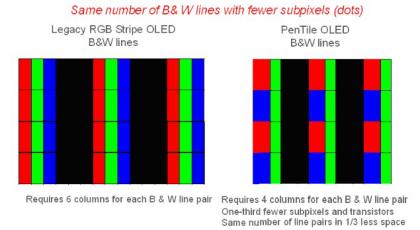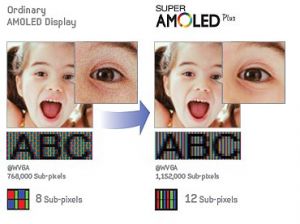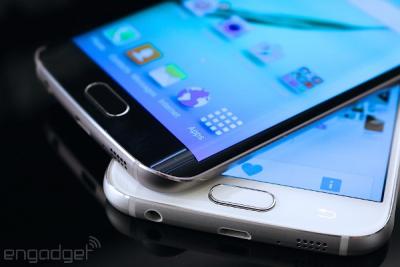PenTile RGBG matrix technology explained
Samsung's Pentile matrix technology is a sub-pixel design architecture family. The basic PenTile structure is the RGBG matrix. In RGBG PenTile displays there are only two subpixels per pixel, with twice as many green pixels than red and blue ones. You can see a PenTile matrix vs a Real-Stripe one on the images below (the PenTile is on the right):
The Pentile technology was commercialized by Clairvoyante. In March 2008, Samsung bought the company's PenTile related IP and technology, and formed a new company called Nuovoyance to continue development of this display technology. Here's an image from Nuovoyance showing Pentile vs RGB matrix (which they call a 'legacy' matrix):

PenTile relies on the human eye design - if you reduce the number of blue subpixels, you barely reduce the image quality. There are other advantages to PenTile displays (for example longer liftime, which will be explained below). But even Samsung admits that a real-stripe RGB matrix is better than Pentile, for example here's some marketing image from Samsung showing how a non-Pentile display (the Super AMOLED Plus) is better than the pentile Super AMOLED:

Some people indeed do not like PenTile displays. Mostly it seems because there is a visible pattern when you look at the display up close. Your eyes get used to this pattern quickly though, and the higher resolution the display is, the less visible the pattern is. Modern PenTile OLED displays reach very high pixel densities that make it virtually impossible to notice the patern.
Samsung's AMOLED and Super AMOLED displays
Samsung uses PenTile technology in virtually all of their Super AMOLED displays, which are used in most of the company's smartphones - including the Galaxy S7 and S7 edge.

Diamond Pixel Pentile
Samsung's latest Super AMOLED displays adopt a new subpixel arrangement called Diamond Pixel. The first phone to use this pentile type was the Galaxy S4 (later phones adopted a slightly different Diamond pattern). In a Diamond Pixel display, there are twice as many green subpixels as there are blue and red ones, and the green subpixels are oval and small while the red and blue ones are diamond-shaped and larger (the blue subpixel is slightly larger than the red one). The diamond shapes were chosen to maximize the sub-pixel packing and achieve the highest possible PPI. The greens are oval because they are squeezed between the larger red and blue ones.
![]()
Pentile displays last longer
One of the advantages of PenTile displays is that they last longer. In fact today this is one of the major reasons Samsung are using PenTile for high-resolution (over 230 ppi) OLEDs. Read here for Nuovoyance (Samsung's company in charge of PenTile) explanation.
Further reading
The latest Pentile news:
The OLED-Association responds to DisplayMate's Nexus-One tests
A few days ago we posted about DisplayMate's Nexus-One display tests. Basically they are very unhappy with the OLED's performance, especially when compared to the iPhone's LCD.
Now Barry Young from the OLED-Association has sent us his response to these tests:
Last week, there was an incredible amount of Internet chatter, generated by one well-regarded tester (DisplayMate) and one blogger (DisplayBlog) comparing the AMOLED display in the Nexus I with the LTPS LCD in the iPhone. In short, according to the tester, the AMOLED didn’t measure up. The evaluation was, to my knowledge, the first in-depth scientific comparison of the two displays. Did they help or just confuse the situation? There was a time when display architectures and the measurements of performance were relatively simple:
The Nexus One's OLED gets an in-depth technical check, turns out very bad
The DisplayBlog and DisplayMate are working on an interesting series of tests for Google's Nexus One phone AMOLED display and the iPhone's 3GS display. It's not finished yet, but they have posted the first tests of the AMOLED display. There's a lot of technical information, but here are the main conclusions:
- The OLED is 800x480, but uses PenTile technology, that has two-thirds of the total number of sub-pixels found on an 800x480 LCD, so it won’t be quite as sharp as a typical 800x480 display.
- The display has only 16-bits color depth, with just 32 or 64 intensity levels. DisplayMate say this is unacceptable for a high performance phone such as the Nexus One. The colors are coarse and inaccurate as a result.
- The display is excellent for text, icons and menu graphics, but poor for image and awful for resolution scaling. The problem with resolution scaling lies in the Android OS which uses a "laughably primitive scaling algorithm".
- The peak white brightness is just 229 cd/m2 which is rather poor.
- The black brightness is outstanding (0.0035 cd/m2) - so dark it is hard to measure or even detect.
- The contrast ratio (65416) is great, the highest they have measured for a production display.
- The screen reflectance is relatively high and washes out the image, makes it hard to view in bright conditions.
- The phone uses Dynamic Color and Dynamic Contrast which results is exaggerated colors and stretching of images.
Samsung SDI to launch 3" WVGA (480 x 800) AMOLED panel
 Samsung SDI this week will announce its intention to produce the world's first 3-inch WVGA (480 x 800) active-matrix (AM) OLED panel, using PenTile subpixel rendering technology from Clairvoyante Inc. PenTile technology makes it possible to attain WVGA performance by eliminating one-third of the subpixels while maintaining the same display resolution.
Samsung SDI this week will announce its intention to produce the world's first 3-inch WVGA (480 x 800) active-matrix (AM) OLED panel, using PenTile subpixel rendering technology from Clairvoyante Inc. PenTile technology makes it possible to attain WVGA performance by eliminating one-third of the subpixels while maintaining the same display resolution.
Anticipating a strong demand for OLED technology, Samsung recently invested in additional capacity. Industry research group Display Search predicts that the AM OLED market will grow to $5.58 billion by 2011, up from $220.5 million in 2007. Samsung has been fabricating OLED panels since August 2002 for applications in car audio systems, electronic games, MP3 players and, now, cell phones.
Pagination
- Previous page
- Page 5



